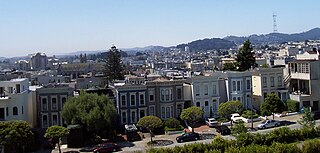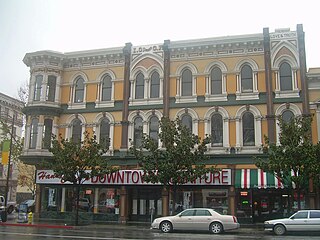
Victorian architecture is a series of architectural revival styles in the mid-to-late 19th century. Victorian refers to the reign of Queen Victoria (1837–1901), called the Victorian era, during which period the styles known as Victorian were used in construction. However, many elements of what is typically termed "Victorian" architecture did not become popular until later in Victoria's reign, roughly from 1850 and later. The styles often included interpretations and eclectic revivals of historic styles (see Historicism). The name represents the British and French custom of naming architectural styles for a reigning monarch. Within this naming and classification scheme, it followed Georgian architecture and later Regency architecture and was succeeded by Edwardian architecture.

Japantown, also known historically as Japanese Town, is a neighborhood in the Western Addition district of San Francisco, California. Japantown comprises about six city blocks and is considered one of the largest and oldest ethnic enclaves in the United States.

Bernard Ralph Maybeck was an American architect. He worked primarily in the San Francisco Bay Area, designing public buildings, including the Palace of Fine Arts in San Francisco, and also private houses, especially in Berkeley, where he lived and taught at the University of California. A number of his works are listed on the National Register of Historic Places.

Russian Hill is a neighborhood of San Francisco, California. It is named after one of San Francisco's 44 hills, and one of its original "Seven Hills".

The Western Addition is a district in San Francisco, California, United States.

Aquatic Park Historic District is a National Historic Landmark and building complex on the San Francisco Bay waterfront within San Francisco Maritime National Historical Park.

The Downtown Historic District of San Jose, California is a designated U.S. Historic District area of the city roughly the size of one square block. It is bounded by S. First Street to the west, E. San Fernando Street to the south, S. Third Street to the east, and E. Santa Clara Street to the north, but also includes the south side of E. Santa Clara Street between Third and Fourth Streets.

The James C. Flood Mansion is a historic mansion at 1000 California Street, atop Nob Hill in San Francisco, California, USA. Now home of the Pacific-Union Club, it was built in 1886 as the townhouse for James C. Flood, a 19th-century silver baron. It was the first brownstone building west of the Mississippi River, and the only mansion on Nob Hill to structurally survive the 1906 San Francisco earthquake and fire. It was declared a National Historic Landmark in 1966.

Broadway–Flushing is a historic district and residential subsection of Flushing, Queens, New York City. The neighborhood comprises approximately 2,300 homes. It is located between 155th and 170th Streets to the west and east respectively, and is bounded on the north by Bayside and 29th Avenues, and on the south by Northern Boulevard and Crocheron Avenue. Broadway–Flushing is listed on the National Register of Historic Places.

The Frank G. Edwards House is a historic residential building built in 1883, and located at 1366 Guerrero Street in the Noe Valley section of San Francisco, California.

Goodman Building, also known as the Emeric Building and the St. Beryl Hotel, is a historic commercial and residential building, built in 1860 and located at 1117 Geary Boulevard in Cathedral Hill, San Francisco, California.

Russian Hill-Vallejo Street Crest District is a 4-acre (1.6 ha) historic district in Russian Hill, San Francisco, California, that was listed on the National Register of Historic Places on January 22, 1988, for the people, events and architecture. The area is a residential enclave defined by retaining walls and natural bluff.

The Russian Hill-Paris Block Architectural District is a 1.5-acre (0.61 ha) historic district located in the Russian Hill area of San Francisco, California, that was listed on the National Register of Historic Places on January 7, 1988, for architecture. The area is a residential enclave.

The Vollmer House is a historic house built between 1876 and 1885, and located in the Japantown area in San Francisco, California. The house is known for its outstanding decorative details on the exterior.

The Hensley Historic District, also known as Northside Residential District, is a U.S. historic district and residential neighborhood in San Jose, California. The neighborhood is northeast of downtown and is roughly bounded by East Julian Street, North 1st Street, North 7th Street, and East Empire Street. It is listed as a California Historical Landmark since June 21, 1983; and is listed as one of the National Register of Historic Places (NRHP) since June 21, 1983.

The Bush Street–Cottage Row Historic District is a historic district located in the Japantown area of San Francisco, California, U.S.. The area is a residential enclave comprising 20 historical residences, a walkway, and a small park. It is listed as a San Francisco Designated Landmark since September 1991, under the name " Bush Street–Cottage Row"; listed as a listed California Historical Landmark since December 27, 1982; and listed on the National Register of Historic Places on December 27, 1982, for architecture.

The Liberty Hill Historic District is a historic district located in the Dolores Heights neighborhood of San Francisco, California, U.S.. It is a residential neighborhood bound by 20th, Mission, Dolores, and 22nd Streets. It is listed as a San Francisco Designated Landmark since October 25, 1985.

The Lower Nob Hill Apartment Hotel District is a historic district located in downtown San Francisco, California, in an area that sits between the Nob Hill and Tenderloin neighborhoods. It covers roughly a five-block stretch on the southern slope of Nob Hill, but due to its location between California Street and Geary Street, the district is often considered part of downtown San Francisco. The area is sometimes referred to as 'Tendernob,' a colloquial term that reflects the blending of the two neighborhoods, and is also commonly called 'Lower Nob Hill' by real estate agents and developers to market properties in this transitional zone.

The Uptown Tenderloin Historic District is a historic district located in the Tenderloin neighborhood of San Francisco, California, U.S.. It has 408 contributing buildings and covers roughly a 33-city block radius in downtown San Francisco. The Uptown Tenderloin Historic District was listed on the National Register of Historic Places on February 5, 2009, for architecture and social history.






















